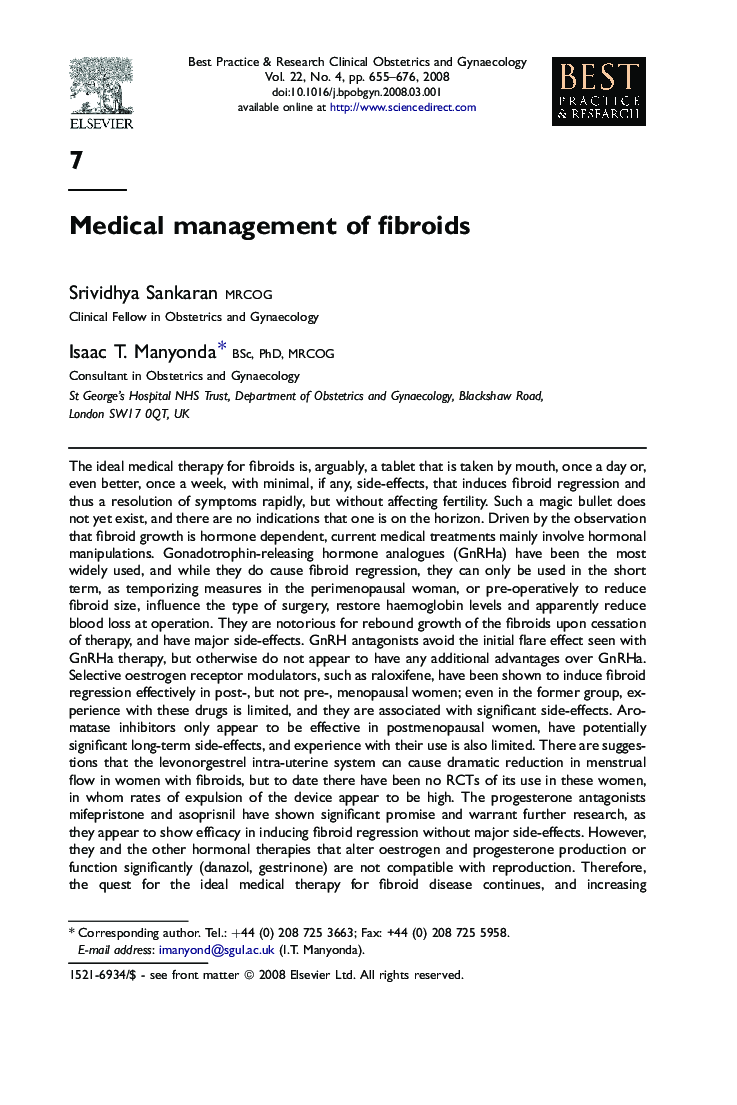| کد مقاله | کد نشریه | سال انتشار | مقاله انگلیسی | نسخه تمام متن |
|---|---|---|---|---|
| 3907936 | 1251091 | 2008 | 22 صفحه PDF | دانلود رایگان |

The ideal medical therapy for fibroids is, arguably, a tablet that is taken by mouth, once a day or, even better, once a week, with minimal, if any, side-effects, that induces fibroid regression and thus a resolution of symptoms rapidly, but without affecting fertility. Such a magic bullet does not yet exist, and there are no indications that one is on the horizon. Driven by the observation that fibroid growth is hormone dependent, current medical treatments mainly involve hormonal manipulations. Gonadotrophin-releasing hormone analogues (GnRHa) have been the most widely used, and while they do cause fibroid regression, they can only be used in the short term, as temporizing measures in the perimenopausal woman, or pre-operatively to reduce fibroid size, influence the type of surgery, restore haemoglobin levels and apparently reduce blood loss at operation. They are notorious for rebound growth of the fibroids upon cessation of therapy, and have major side-effects. GnRH antagonists avoid the initial flare effect seen with GnRHa therapy, but otherwise do not appear to have any additional advantages over GnRHa. Selective oestrogen receptor modulators, such as raloxifene, have been shown to induce fibroid regression effectively in post-, but not pre-, menopausal women; even in the former group, experience with these drugs is limited, and they are associated with significant side-effects. Aromatase inhibitors only appear to be effective in postmenopausal women, have potentially significant long-term side-effects, and experience with their use is also limited. There are suggestions that the levonorgestrel intra-uterine system can cause dramatic reduction in menstrual flow in women with fibroids, but to date there have been no RCTs of its use in these women, in whom rates of expulsion of the device appear to be high. The progesterone antagonists mifepristone and asoprisnil have shown significant promise and warrant further research, as they appear to show efficacy in inducing fibroid regression without major side-effects. However, they and the other hormonal therapies that alter oestrogen and progesterone production or function significantly (danazol, gestrinone) are not compatible with reproduction. Therefore, the quest for the ideal medical therapy for fibroid disease continues, and increasing understanding of fibroid biology is ushering in non-hormonal therapies, although all are confined to laboratory experimentation at present. In the meantime, surgical and radiological approaches remain the mainstay effective therapies.
Journal: Best Practice & Research Clinical Obstetrics & Gynaecology - Volume 22, Issue 4, August 2008, Pages 655–676